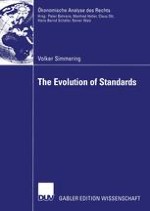2003 | OriginalPaper | Chapter
Voting on Harmonization
Author : Volker Simmering
Published in: The Evolution of Standards
Publisher: Deutscher Universitätsverlag
Included in: Professional Book Archive
Activate our intelligent search to find suitable subject content or patents.
Select sections of text to find matching patents with Artificial Intelligence. powered by
Select sections of text to find additional relevant content using AI-assisted search. powered by
In the previous sections, we have identified several potential market failures associated with network effects, and, moreover, we have asked whether and how “policy” or some “authorized body” should intervene. Considering the authorized body as an entity that strives to achieve some well-defined goal, we however ignored the decision process within such a body. For example, in section 4, we assumed that Europe’s official standardization bodies (ESBs) set standards in order to produce a shift from variety to harmonization. Although we argued that bureaucratic incentives common to the ESBs’ decision makers might bias that body’s objective function, we abstracted from possible conflicts among the decision makers within the ESBs. In fact, conflicts are likely to be present within such bodies. Recall that, e.g., CEN/CENELEC’s members are the “official” national standardization bodieslike CEN/CENLEC and ISO/IEC209, apply voting. However, is voting an appropriate mechanism for collective decision-making in such bodies?210
